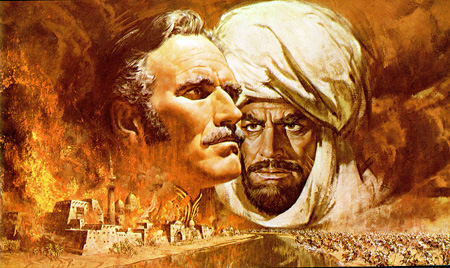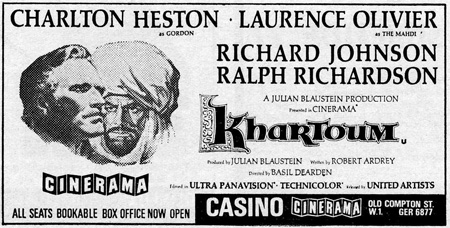"Khartoum" in Ultra Panavision 70 |
Read more
at in70mm.com The 70mm Newsletter |
| Written by: Rick Mitchell, © 2008, Universe rights reserved. | Date: 20 May 2008 |
 Original
artwork from the souvenir program Original
artwork from the souvenir programA new 70mm print, by Fotokem, of one of the nine films shot in this widest of formats, was shown at the American Cinematheque's Egyptian Theater last night (and for you Angelenos will be shown at the Aero in Santa Monica next Sunday). Like all of "wide screen" formats experimented with after the introduction of Cinerama, Ultra Panavision, originally known as MGM Camera 65, was designed to be shown on a curved screen, though ones with the degree of curvature used for Cinerama, though UP became the foundation of "Single lens/film Cinerama". The screen at the current Egyptian is totally flat (as is the Aero's) and this screening offers an opportunity to deal with the biggest longstanding argument against aspect ratios wider than 1.85:1 in the last 55 years, arguments which actually began in the Fall of 1930 when Wide Film productions of that period were first seen in Los Angeles and New York. One major benefit of such a rare screening is the opportunity to make these evaluations with a large sharp image on a big screen one as opposed to trying to deal with a video image letterboxed to an approximate 2.75:1 AR, even on what's considered the largest, highest quality video monitor. The frame still does look like that of a mural, but with a 35mm, the process' shortest focal length are not really harmed by the frame's shape. In fact, the distortions inherent in short focal length lenses give even medium shots in interiors a faux three dimensional effect that gives the impression of being the view of a person at the camera's position. The problem becomes more apparent with the flatter field-of-view of longer lenses depending on how many vertical elements there are in the frame and how symmetrically they're placed across it. Close-ups can be considered a problem, the usual complaint about a face in the center of the frame with vast expanses of nothing on either side of it, though this can be handled with selective placement of background set decorations and/or lighting. This discussion is moot anyway because "Khartoum" was the last feature to be shot in Ultra Panavision. The lenses were too big and heavy to be used on car mount cameras for "Grand Prix" (I know, I've held one), Stanley Kubrick had already rejected their use for "2001", and since the non "Cinerama" 70mm engagements of most UP films had been with optically extracted spherical 2.21 prints (the old Egyptian was apparently one of the few non-Cinerama theaters in the US to show "Ben Hur" and "Mutiny of the Bounty" full width), the consensus was that the public wouldn't notice that the "Single lens Cinerama" view had narrowed. I learned recently that the last use of UP was for a short film for a Japanese theme park made in the early 90s. An article posted on in70mm.com mentions the authors had wanted to shoot a short in the process in the late Nineties but Panavision discovered the surviving lenses had developed problems which made them unusable; they were also not designed for use on the reflex 65mm cameras Panavision introduced in the late Eighties. And yet, at a time when the theatrical industry is competing with the home video industry, something that provides theatrical audiences with an experience that could never really be repeated in the home and uses existing technology, might really be worth taking another look at. And combining it with Super Dimension 70 on the right film.... |
More
in 70mm reading: Ultra Panavision 70 - almost like a real story Ultra Panavision 70 Film Panavision Steinheil Charlton Heston Who's Rick Mitchell? Panavision and the Resurrecting of Dinosaur Technology |
 Unfortunately,
"Khartoum" wouldn't be that film. It was one of the rash of roadshow
projects greenlit in the wake of the peak period for such films, Nov. 1962
to Dec. 1963, when all sorts of projects were considered for expanding to
roadshow status, but was a curious choice, especially for one intended to be
exploited in the "Single lens Cinerama" process. Though clearly inspired by
"Lawrence of Arabia", the martyrdom of "Chinese" Gordon was also
curious subject choice for a film whose likely cost would require the kind
of worldwide success that the most popular of previous roadshows had
achieved. I'd never heard of Gordon before this film was publicized and
doubt that most Americans who weren't history buffs in general and British
history in particular had either. And like "Lawrence of Arabia", it
is done in the austere reserved, almost documentary approach found in
"serious" British epics. Though it worked for "Lawrence of Arabia",
it didn't work to draw audiences to "Khartoum" or any of the other
similar epics done by British filmmakers in 35mm anamorphic over the next
four years. Unfortunately,
"Khartoum" wouldn't be that film. It was one of the rash of roadshow
projects greenlit in the wake of the peak period for such films, Nov. 1962
to Dec. 1963, when all sorts of projects were considered for expanding to
roadshow status, but was a curious choice, especially for one intended to be
exploited in the "Single lens Cinerama" process. Though clearly inspired by
"Lawrence of Arabia", the martyrdom of "Chinese" Gordon was also
curious subject choice for a film whose likely cost would require the kind
of worldwide success that the most popular of previous roadshows had
achieved. I'd never heard of Gordon before this film was publicized and
doubt that most Americans who weren't history buffs in general and British
history in particular had either. And like "Lawrence of Arabia", it
is done in the austere reserved, almost documentary approach found in
"serious" British epics. Though it worked for "Lawrence of Arabia",
it didn't work to draw audiences to "Khartoum" or any of the other
similar epics done by British filmmakers in 35mm anamorphic over the next
four years.The new print is gorgeous. I have a beat-up 16mm IB print, anamorphic of course, and where designed to be so, the colors are as vivid as in the IB print. Having never heard this film in stereo and no magnetic stereo dubs of British films from this period recently except "Lord Jim", I have no idea how reflective the track is of the original except that it sounded too cleaned up to me, no feeling of atmosphere even in scenes clearly shot on the stages at Pinewood. There is occasional positioning of dialog to the left and/or right sides, but none of the stereo placement of rifle and cannon shots that was often done in other films. The music comes through quite strongly. At present new prints with sound (DTS timecode) have been made on only three Ultra Panavision films, "It's a Mad, Mad, Mad, Mad World", "The Greatest Story Ever Told" and now "Khartoum". Exhibiting them requires not only special projection lenses, but also special adjustments in the venue which may lead to reducing the overall size of the image to get it all on the screen (even the Academy had to do this at its Goldwyn Theater), but anyone interested in wide screen formats should take the opportunity to see one of these prints if shown near them. It might encourage the striking of new prints with sound accessibility on the other films, though, since all of them but "The Hallelujah Trail" are owned by Warner Bros., that's highly unlikely. |
|
|
Go: back
- top -
back issues
- news index Updated 22-01-25 |
|
